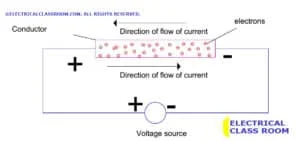The direction of electric current can be a bit confusing topic. Here we have addressed your query. Hope this article shall be helpful to you in understanding the direction of current flow.
Every particle in the nature other than the insulators* has a large number of free electrons in them. These electrons move randomly in all directions within the material under normal conditions. If a certain amount of voltage is applied across these materials, all these electrons start moving from the region of higher potential towards the region of lower potential. This movement of electrons from the region of higher potential to the region of lower potential under electric field constitutes the electric current.
*there will be no free electrons in insulator provided that it is maintained at a normal temperature or room temperature.
Definition of current
Electric current is normally referred to as the flow of charges through a conductor. It can be defined as the amount of charge that flows past a cross-section area in a conductor. In other words, the term “current” can be defined as the rate of flow of charges through a conductor. Read more about Electic Current
The mathematical expression of electric current
Electric current is measured by the number of electrons flowing past a particular point in a conductor or a circuit per unit time.
Where Q is the charge of electrons flowing through the conductor. t is the time of flow in seconds.
In which direction does electric current flow?
The direction of electric current flow is a little difficult to understand to those who have been taught that current flows from positive to negative. There are two theories behind this phenomenon. One is the theory of conventional current and the other is the theory of actual current flow. When Benjamin Franklin was studying charges, the structure of an atom and atomic particles were unknown. Hence he assumed the point of charge accumulation as positive and the point which is deficient of charges as negative. Therefore, the charge is said to flow from positive to negative. This is called conventional current.
But in reality, an electric current is nothing but the flow of electrons. Electrons are negatively charged particles and are attracted towards the positive charge. Also, many experiments have revealed that it is free electrons in a conductor that flows. Negatively charged electrons move from the negative terminal to the positive terminal. This is the direction of the actual current flow.
Direction of current flow in circuit analysis
In terms of circuit analysis, we normally consider the direction of electric current from positive to negative. Mathematically, negative charge flowing in one direction is equivalent to positive charges flowing in the opposite direction. Hence it does not make a difference. One can either consider the flow of current from positive to negative or vice versa during circuit analysis. In fact, positively charged ions can be attracted by negatively charged electrons.
Unit of current
The unit of current is ampere or A. one ampere is equal to the one coulomb per second whereas one coulomb is equal to 6.25 x 1018 electrons. By saying that one ampere of current is flowing through a circuit, it is meant that 6.25 x 1018 electrons are crossing a point in the circuit per second.

Sir you are saying that it was by fault that Benjamin franklin thought that electrons flow from positive to negative but we already know that the truth is electrons flow from negative to positive as there is more electrons accumulated on the negative side compared to the positive side, then why we are still adopting the conventional flow of current?
That is a great question. If you see, the direction of current does not matter unless you are analyzing or designing semiconductor circuits or batteries. During circuit analysis, you can use either of these conventions since the Ohm’s law and Kirchoff’s law are independent of the direction of electron flow. But the thing is you should never apply both the conventions in the same circuit during analysis.
There’s not actually any reason that we haven’t switched to the accurate flow yet but since we’ve adopted the conventional current all over, it would be utter chaos to try and change it. Imagine the United States deciding to drive on the left side of the road all of a sudden, things would fall apart.
Yes this is all true.
So as a practical and useful action.
There is still the requirement of placing
the diode/rectifier the correct way
so the circuit will function in reality.
Sir why combination of capacitor is study in electrostatic chapter and electric current is not study in electrostatic